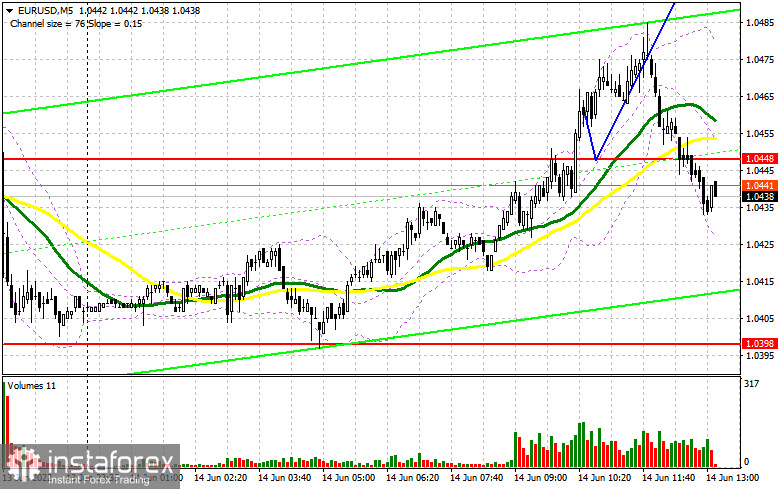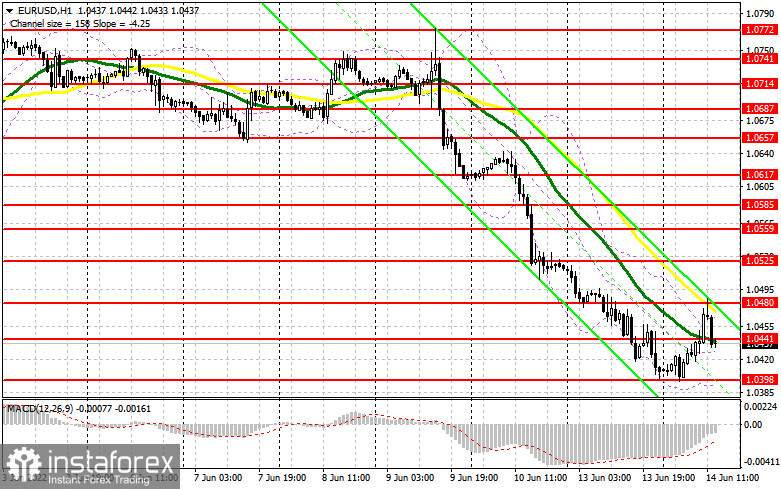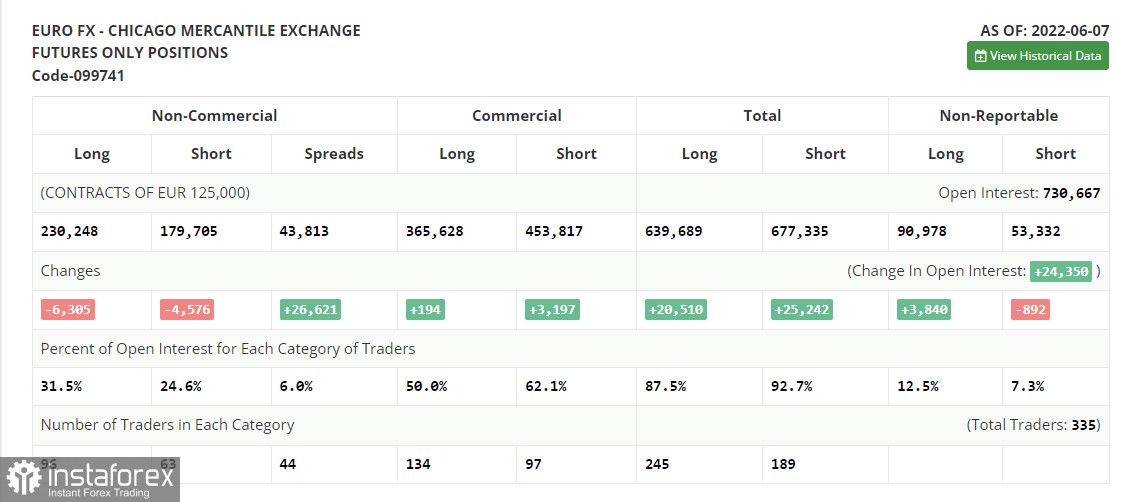Earlier, I asked you to pay attention to the level of 1.0448 to decide when to enter the market. Let's look at the 5-minute chart to clear up the market situation. Data from Germany and the eurozone did not encourage traders. That is why bulls failed to benefit from good news and fix at 1.0448. The pair broke this level, but did not downwardly test. As a result, traders did not receive an entry signal. However, they neither got a sell signal from 1.0495. The pair lacked just several pips to test it. However, in the second part of the day, the situation may change a bit.

Conditions for opening long positions on EUR/USD:
During the American session, the US is going to disclose its producer price index data. The report may push the euro even deeper to this month's low. In this case, bulls will have to do their best to protect 1.0398. Only a false break of this level will give a long signal with the target at the intermediate resistance level of 1.044 formed in the first part of the day. Notably, tomorrow, the US Fed will hold a meeting. That is why bears could be very cautious protecting the level of 1.0398. In case of a false break of 1.0441, bulls may try to reach today's high of 1.0480. A break and a downward test of this level may slightly affect sellers' stop orders, thus providing traders with a long signal. In this case, the pair may climb to 1.0525. The next target is located at 1.0559, where it is recommended to lock in profits. If the euro/dollar pair continues falling in the second part of the day and buyers fail to protect 1.0441, pressure on the euro will rise. If buyers' stop orders are executed below this level, the pair may slide to 1.0398. That is why it will be wise to open long positions after a false break. It is also possible to buy the currency from 1.0353 or lower – from 1.0306, expecting an increase of 30-35 pips within the day.
Conditions for opening short positions on EUR/USD:
Bulls do not have any chance to succeed. Early today, sellers did not allow buyers to approach 1.0499, thus proving their dominance in the market. If the pair increases in the second part of the day, a false break of the new resistance level of 1.0480 will give a sell signal with the target at the support level of 1.0441. A break and settlement below this level as well as an upward test will give an additional sell signal, thus seriously affecting buyers' stop orders. Against the backdrop, the pair may slide to 1.0398. A break and settlement below 1.0398 will push the price to 1.0353 and 1.0303, where it is recommended to close sell orders. If the euro/dollar pair rises during the US trade and bears fail to protect 1.0480, it will be better to avoid selling until the price hits 1.0525. A false break of this level will provide traders with a sell signal. It is also possible to go short from 1.0559 or higher – from 1.0585, expecting a drop of 30-35 pips.

COT report
According to the COT report from June 7, the number of both long and short positions slumped. The fact is that most traders were very cautious expecting the ECB meeting. That is why market activity was very low. The time showed that it was a perfect idea to avoid trading. Last week, the ECB's representatives said that the regulator would raise the benchmark rate at the following meeting. However, even this announcement failed to prop up the euro. The US inflation data published on Friday caused a decline in risk assets, including the euro. A further trend of the euro/dollar pair depends on the Fed's decision on monetary policy and forecasts for the next few years. If the regulator's stance remains aggressive, the euro is likely to slide deeper to new yearly lows. The COT report unveiled that the number of long non-commercial positions declined by 6,305 to 230,248, while the number of short non-commercial positions dropped by 4,576 to 179,705. Although the euro is rather cheap, traders are not very interested in it. According to the week's results, the total non-commercial net position decreased to 50,543 against 52,272 a week earlier. The weekly closing price dropped to 1.0710 compared to 1.0742.

Signals of indicators:
Moving Averages
Trading is performed below 30- and 50-day moving averages, thus pointing to the continuation of the bearish trend.
Note: The period and prices of moving averages are considered by the author on the one-hour chart that differs from the general definition of the classic daily moving averages on the daily chart.
Bollinger Bands
If the pair increases, the resistance level will be located at the higher limit of the indicator at 1.0465.
Description of indicators
- Moving average (moving average, determines the current trend by smoothing volatility and noise). The period is 50. It is marked in yellow on the chart.
- Moving average (moving average, determines the current trend by smoothing volatility and noise). The period is 30. It is marked in green on the graph.
- MACD indicator (Moving Average Convergence/Divergence - convergence/divergence of moving averages). A fast EMA period is 12. A slow EMA period is 26. The SMA period is 9.
- Bollinger Bands. The period is 20.
- Non-profit speculative traders are individual traders, hedge funds, and large institutions that use the futures market for speculative purposes and meet certain requirements.
- Long non-commercial positions is a total number of long positions opened by non-commercial traders.
- Short non-commercial positions is a total number of short positions opened by non-commercial traders.
- The total non-commercial net position is a difference in the number of short and long positions opened by non-commercial traders.
 English
English 
 Русский
Русский Bahasa Indonesia
Bahasa Indonesia Bahasa Malay
Bahasa Malay ไทย
ไทย Español
Español Deutsch
Deutsch Български
Български Français
Français Tiếng Việt
Tiếng Việt 中文
中文 বাংলা
বাংলা हिन्दी
हिन्दी Čeština
Čeština Українська
Українська Română
Română

